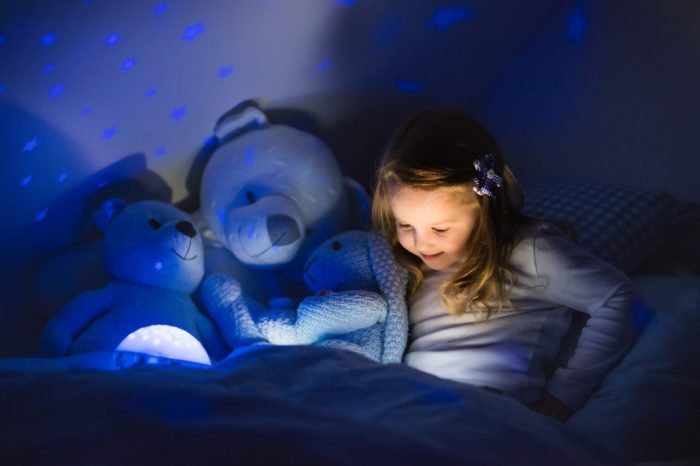
The Best Life Hack for Beating Bedtime Battles
Are you tired of the bedtime battle? You know, the daily conflict that occurs between you and your children to get them to sleep? Perhaps your child is anti-bedtime and creates a skirmish to get to the bedroom, but then deals ok with it. Or, maybe your child is the type to leave their bed several times to tell you they can’t sleep, before wearing themselves out and finally catching zzz’s a few hours later? No matter what you and your child’s bedtime struggle looks like, there are some scientific studies that show why bedtime can be difficult for kids. While you may not realize it, one primary factor is melatonin production, which can be thrown off by the type and tone of lighting in the home. Specifically, the light around and in the child’s bedroom, and how much blue light (emanating from technology), is taken in just before bedtime. Blue light can be found in high amounts from technology screens as well as ordinary light bulbs of lower quality.
One of the biggest factors affecting a child’s bedtime routine? Light.

Studies show that the more blue light a child is susceptible to, the harder the body has to work to produce melatonin, the hormone that regulates sleep. According to a New York Times article, the general consensus is that “Children’s eyes let in more light than adults’ eyes do.” If the blue light radiating off of our technological devices affects adults so much, that only means that children are that much more affected the same light. So, those bedtime videos, games and stories that may come from a phone, tablet, or TV, all are stunting melatonin production in the child, resulting in a more difficult bedtime transition.
In the study that the NY Times cited, it showed that the average beginning of the child’s biological night (when melatonin secretion began) was approximately 7:47 P.M with the average bedtime being about 8:27 P.M. This scenario occurred when the children were exposed to a living situation of being in a dim-lit “cave” of sorts, where no bright light interfered with the beginning of their biological night. However, they alternatively studied how light exposure suppressed melatonin production and found that the rate suppressed production by 90%, with the effects lingering long after the children retired into a dim-lit space.
What does that mean? It means that blue light exposure before bedtime should be restricted, and that will result in a more seamless transition from day to night. Nowadays, you can go into your phone settings and set “night mode”, which will change the screen light from a harsh blue to a warm yellow at a time that you choose. If technology is a big part of your bedtime routine, this solution may behoove you, but you might find it more beneficial to eliminate all exposure to blue light within an hour of bedtime.

Turning the Sleep Space into a Dark Cave
So, you’re interested in the idea of a “dark cave” to help with the bedtime battle, but you don’t want to rewire or renovate in an expensive way. We’re here to tell you that this doesn’t have to be a big budget blow. After researching the best color light for sleep, results show that warm LED lights take the cake. If you think about it (and think about the color wheel) warm tones (red, orange, yellow) are the direct opposite of cooler colors (green, blue, purple) so naturally, you’d think warm light would act inversely to cool light. The authors of a Life Hack article suggest that in the evening, a switch should be made from bright, abrasive overhead lights in favor of table lamps, or smaller sconces would held to maintain a proper circadian rhythm. Typically, these smaller light sources are accompanied by warmer bulbs (under 3000k), which is the crux of the matter. Warm light more closely mimics the setting sun and is gentler on the eyes (and better for the melatonin production) and encourages a smooth transition from being awake to falling asleep. Keeping these warmer, eye level light sources on around the home after sunset can yield a simpler, smoother transition, especially for children, from day to night.
A supplementary behavior that will take time to adjust would be down a similar vein to restricting blue-light technology would be to adjust the amount of direct light on the child’s eyes. Illuminated technology (e-readers, tablets, phones, televisions, computers) could and should be used indirectly in relation to a child at nighttime (say, the parent reads off of the tablet while the child lays tucked in, or audio is played without video). This reduces the direct blue light shining into the eyes of a child, and will, therefore, reduce the suffocation of melatonin production. Using book lights or table lamps to light an activity (say, reading an old-fashioned bedtime story) indirectly lights the source of activity, so there is less strain on the child’s eyes. To reiterate, the best color light to promote sleep is any variant of warm light, perhaps yellow or amber light.
A third option would be installing dimmer switches around the house so that you can control when the lights go from high to low. If you have these switches around the house, you can ensure that even the overhead lights go from bold and bright to soft and low consistently across your house. It saves the necessity to purchase additional table lamps or installing hallway sconces if you’d rather have a holistic household solution.

Quick Tips for Lighting a House to Promote Sleep
So, maybe your child is afraid of the dark. We all know we had our bouts of fear for monsters in the bed or in the closet, waiting for the parents to slink away and for the lights to go off. There’s no discounting a child’s fear here. Instead, we propose simple solutions to combat that with night lights. The quick tip here is to ensure that bedtime lights are kept low in location and low in brightness. If they’re out of the direct line of sight of the child, they won’t harm the melatonin production and general sleep cycle of the child, and the light provides that safety blanket from the scaries lurking in the dark. Keep in mind what we’ve explored about light temperature, and seek out night lights that contain (or can be mounted with) warmer light bulbs rather than cool bulbs (many can be found marked as low blue light bulbs).
We Have the Products to make Bedtime a Breeze
The fact of the matter is that light affects sleep and that children’s eyes are more susceptible to light, which makes their nighttime transition bumpier. Luckily, light is something you can control, for the most part. You can buy blackout shades, change out light bulbs, opt for the best color light to promote sleep, enhance melatonin production with warm LED lights, and set an off-time for electronics. Whatever you choose to do, Lit Living can help you control your homes’ light. Making small changes like the ones mentioned earlier can be the first step toward putting your kids to bed (and getting them to fall asleep) with no hiccups.
